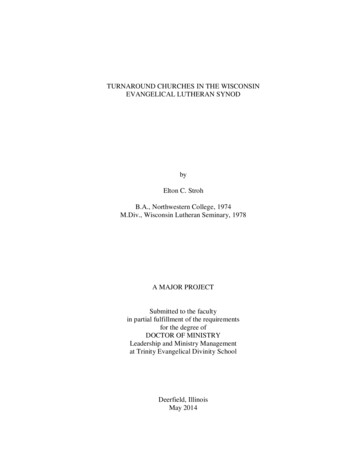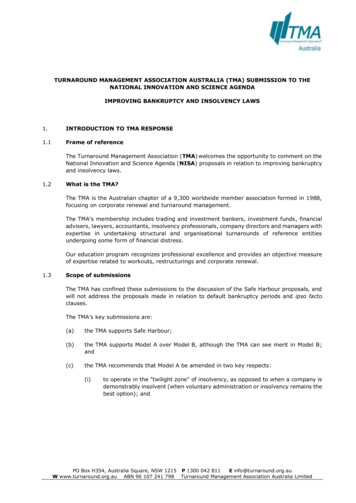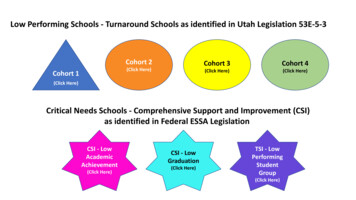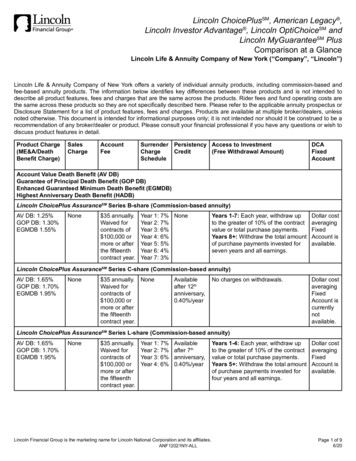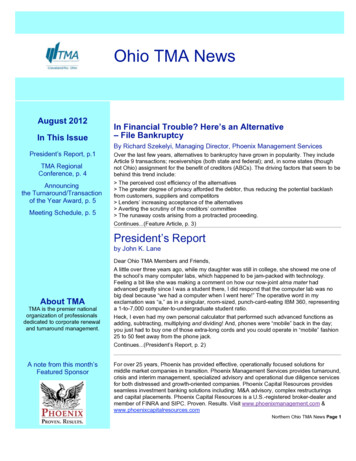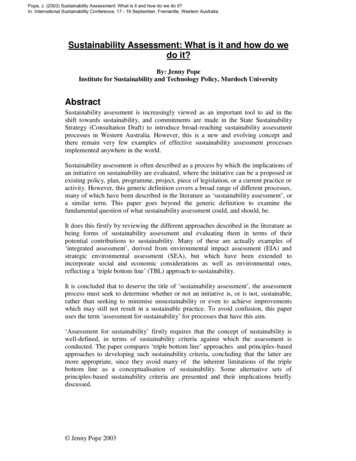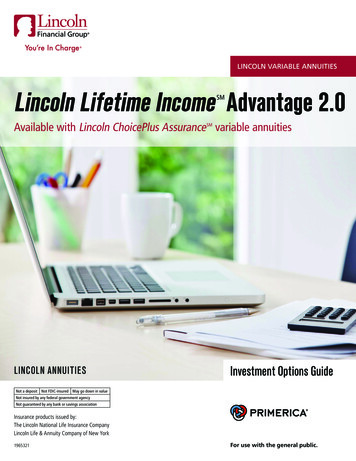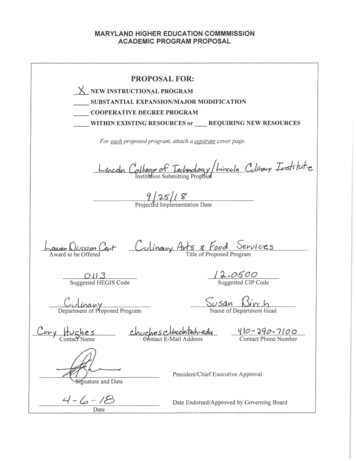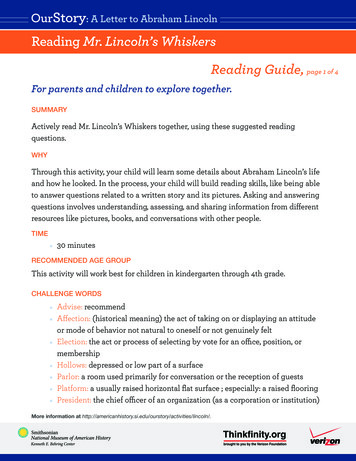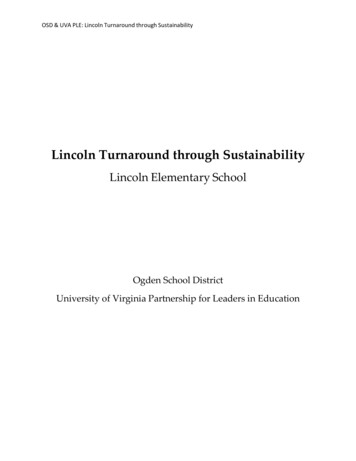
Transcription
OSD & UVA PLE: Lincoln Turnaround through SustainabilityLincoln Turnaround through SustainabilityLincoln Elementary SchoolOgden School DistrictUniversity of Virginia Partnership for Leaders in Education
GoalStory Board #5: Lincoln Turnaround through SustainabilityBy Jenai Ali EmmelTo produce inspirational stories of what this work takes, similar to what Paul Bambrickwrites in stories of practice in Leverage Leadership or organizations like TFA or TNTPput on their website to highlight the importance of leadership & help come to life brieflywhat leaders did to make a difference for students.SchoolLincoln Elementary SchoolPrincipalRoss LuncefordDistrictOgden School DistrictStyleCase StudyStrategyReading Instruction Non-Academic Tier 3 Student Supports DistributedLeadership and PLCs Adult Culture Leadership Team MeetingsLearning LaunchInstituting a strategic and consistent leadership team meetingLaunch StatusHighlightFrom Turnaround to Sustainable PracticeNarrativeLeader ProfileRoss Lunceford is a seasoned educator and an award-winning principal in Ogden SchoolDistrict (OSD). He began his career as a 6-8 teacher and spent 5 years teaching readingand ESL at the middle school level. He became a principal of an affluent and relativelyhigh-performing school in 2002. Although he was not an assistant principal prior to therole, he was immediately successful in improving student performance. Ross became theprincipal of three other schools, with varying demographics, before being assigned toLincoln Elementary School-the third school in his leadership portfolio with Title 1 status.School ProfileLincoln Elementary School serves just under 600 students from diverse backgrounds. Thenumber of students receiving free and reduced lunch qualifies it as Title 1 school basedfederal guidelines. A few years ago, Lincoln was not doing well. While there were goodteachers in the building, the school suffered from inconsistent teaching practice, a negativeadult culture, and a small percentage of students with intensive socio-emotional needs.Despite the potential within staff and students, Lincoln Elementary was an F school.Call to ActionOn Friday, Ross received a phone call from central office. The principal at LincolnElementary School had been removed that day. Ross had been assigned to take his place.On Monday, Ross joined the Superintendent in announcing the transition to faculty duringan all-call staff meeting. Ross made only one statement that day: “I am here to supportyou.”20
Leadership TeamWhen Ross became the Principal at Lincoln, the leadership team was already in place. Adean of students, Jennie De Corso, and a dean of academics, Nicole Lovell, would remainin their roles. However, Ross joined a team that had experienced significant turnover.Students and teachers at Lincoln Elementary had experienced five principals in five years.Deans of students and academics had also turned over frequently.District StrategyOgden School District was also going through a period of transition. OSD establishedinstitutional partners to help them grow the capacity of their district and school leaders.The Partnership for Leaders in Education at the University of Virginia (PLE) became aseminal thought-partner in the area of leadership, instructional infrastructure, support andaccountability, and talent management. The partnership began to shape the districtapproach to supporting struggling schools. Brad Smith became Superintendent in 2011and focused relentlessly on teacher quality. Schools began to experience record levels ofturnover, based on a lack of performance. Ogden also began to support the creation ofteacher teams by investing in professional learning communities at every school. Teachersbegan forming grade-level teams and using protocols to ensure frequent co-planning anddata analysis. Sandy Corroles became Superintendent in 2014 and focused intensively onprincipals and the quality of leadership teams. Many principals were replaced and most ofthe schools in turnaround status began to advance.Turnaround Strategy - Years 1 and 2Ross devoted his first few weeks to examining the quality of teaching and learning atLincoln. He spent 80% of his time conducting informal classroom observations, beingvisible during all transitions, and assessing the strength of grade level teams. After a fewweeks, Ross grew confident in his school improvement plan and his vision for change: A Relentless Focus on ReadingReading instruction was not a cornerstone strategy at Lincoln. While every teacher taughtreading, not everyone had a clear programmatic vision for their classroom. Ross believedthat by adopting Guided Reading, as a school-wide practice, teachers could begin tosupport each other in planning and delivery. He also believed that by narrowing theinstructional focus the quality of professional development would improve. Mostimportantly, several teachers were skilled in guided reading and could assume a leadershiprole in the training and development process. Nicole began to work with grade-levels andindividual teacher leaders to improve guided reading practices over the next two years. Standardized PLC ProcessesProfessional Learning Communities were a long-standing reform strategy within OSD.There were pockets of success at Lincoln – some grade-level teams implementedstructured and meaningful co-planning experiences. However, in order to move Lincolnout of turnaround status, every grade-level PLC would need to be strengthened. Utilizingresources from PLE programming, Ross and Nicole began to standardize PLCs. Gradelevel teams were given protocols to guide their discussions. Nicole modeled PLC21
facilitation to ensure that every team understood the expectation. Eventually, effectivepractices began to spread. Intensive Socio-Emotional Supports for Students (Tier 3)Ross knew that effective reading instruction and consistent PLCs would lead to improvedperformance over time. He was confident in his leadership team and delegated much ofthe daily change management work to them. However, it became clear that some of thechallenges Lincoln faced would require external support. It became obvious that a handfulof students needed much more socio-emotional supports than they had been given. Rossasked the district for more resources including hands-on support from central officeleadership. Ultimately, the district assigned a second dean of students to support theleadership team and the students. Over time, the additional layer of support and consistentresponses from teachers and leaders helped students adjust to the school environment.From Turnaround to Sustainable PracticeLincoln eventually improved its academic standing. After three years, Lincoln advancedfrom an F to a C in the statewide accountability system. However, Ross and his leadershipteam were unsatisfied. They knew that teachers and students could perform at even higherlevels. Ross’s vision was simple – to be the highest achieving Elementary in the OgdenSchool District. To reach that vision, his team would need to continue improving readinginstruction, PLCs, and socio-emotional supports for students. While leadership knew theirvision was ambitious, they also believed it was attainable. However, some teachers beganto show signs of burnout.Learning Launch – Years 3 and 4In order to increase supports for Lincoln, Ross applied to UVAs sustainability programand was accepted based on measurable results. Ross, Jennie, and Nicole developed anext-level vision for Lincoln while in the program. At the heart of their strategy, was apathway to retain their top talent.Ross committed his team to launching three new strategies in an effort to sustainprogress and create opportunity for future gains: Resetting the Adult CultureWhile Lincoln had improved considerably, there were a handful of teachers resistant tochange. The teachers were long-standing veterans, many of whom had dedicated theirentire career to Lincoln. As Lincoln began to turnover teachers and administrators, newfaculty and staff were hired. Eventually, an “us vs. them” dynamic emerged. Veteranteachers were unwilling to embrace new teachers and new approaches to learning. By theend of the summer, the pathway was clear. Ross and team would need to tackle adultbehaviors in a significant way.During a half-day site visit, the leadership team developed a plan to conquer the historyof negativity and to unify the school. With support from a UVA consultant, theydesigned an all-call staff meeting to be implemented the very next day. The team wouldtackle negative comments that had been made and use them to establish a set of norms to22
guide adult interactions. Teachers recognized their own comments and took ownershipover their impact on the culture of the school. Leaders used this opportunity to reaffirmtheir vision, their values, and their desire to be the best. Distributing LeadershipWhile Ross delegated significant aspects of the school improvement plan to members ofhis leadership team and to grade-level leaders, the plan to formally build the capacity ofteachers was foggy. Beyond the PLC format, teachers were unclear on what it meant tobe a teacher leader. What was their role, many asked.The lack of clarity undermined the power of the PLC process and disengaged manyteachers from taking on more responsibility. To address this challenge, Ross and teamdeveloped clear standards for grade-level leaders and for teacher leadership in general.With clear roles in place, teacher confidence grew and as did the leadership team’sability to monitor results. Leadership Team MeetingsLincoln identified clear improvement strategies to move the school out of turnaroundstatus. They also identified a clear pathway to sustain previous gains and to create evenmore momentum. However, the leadership team often approached planning processesinformally. Leadership team meetings were often repurposed or postponed, if theyhappened at all. Teacher leaders did not see them as a good use of time or a meaningfulpart of their school improvement work.However, several members of the leadership team were promoted to roles in centraloffice and the Lincoln leadership team was forced to reset again. New members of theteam pushed for more structure and clarity and wanted to devote year two of thesustainability program to developing strong leadership team meetings. Workingalongside a UVA consultant during the second winter site visit, they began to craft anideal leadership team meeting.After addressing the basics of who would participate, what time, and on what day, theteam began to develop a standardized agenda, communication processes betweenmeetings, clear roles for leadership team meetings, secure alignment to PLC and datameetings, and to institute processes for monitoring results and adjusting strategy.ResultsLincoln continues its journey towards becoming the highest performing elementaryschool in Ogden. After four years of focused reform, Lincoln has advanced from an F toa B (before the shift in cut scores, they had earned an A). Lincoln plans to refine theirefforts in all six strategies in order to cement their achievements.Guidance for PrincipalsLincoln’s secret sauce is reflected in their general improvement strategy. However, thereis one piece of advice Ross would give to other principals – “don’t sweat the small23
stuff.” In retrospect, Ross believes that by staying focused on a clear set of singulargoals, teacher quality and student achievement improved in tandem. His advice is toignore everything that doesn’t directly align with the end game.24
Lincoln Elementary School-the third school in his leadership portfolio with Title 1 status. School Profile Lincoln Elementary School serves just under 600 students from diverse backgrounds. The number of students receiving free and reduced lunch qualifies it as Title 1 school based federal guidelines. A few years ago, Lincoln was not doing well.
